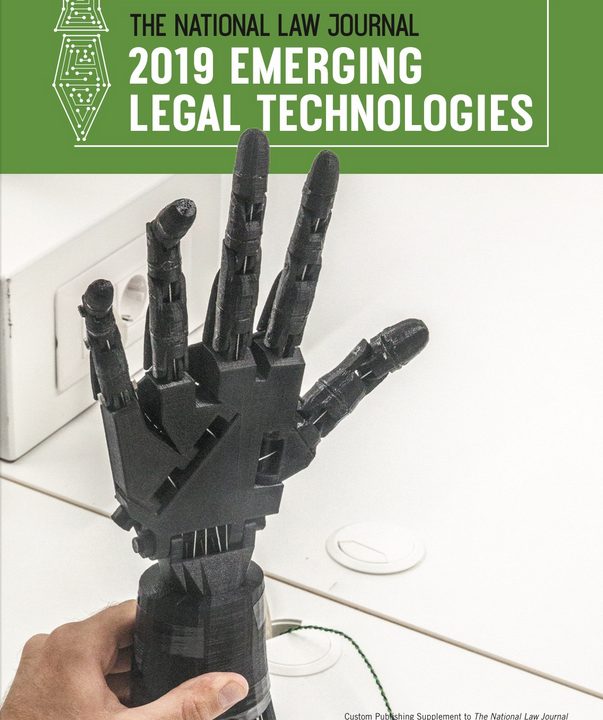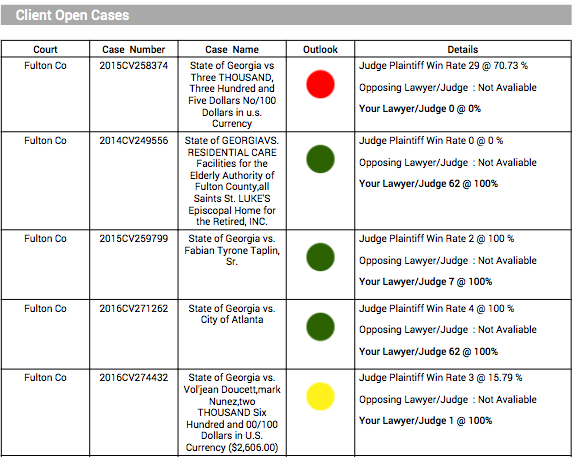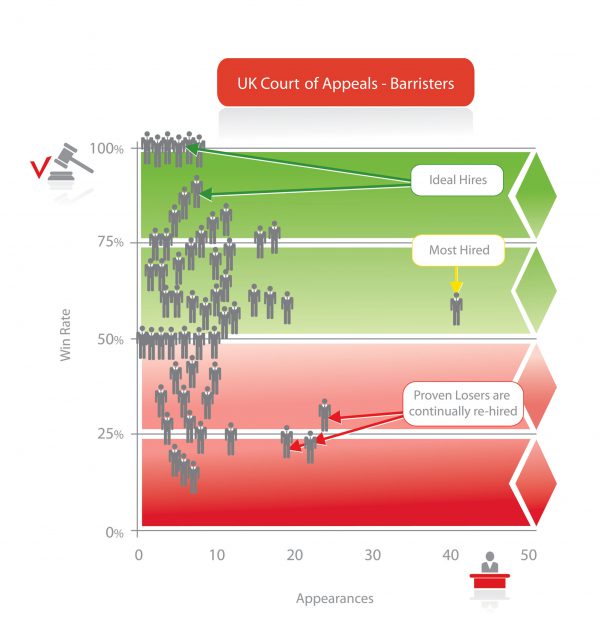A Look at the State of the Art in Business Development Software and Analytics
A Look at the State of the Art in Business Development Software and Analytics

Originally posted in Law Practice Today, published by the American Bar Association
Written by Julie Savarino ON MAY 12, 2016
For law firms of all sizes, technology is both an absolute necessity for efficiency and productivity and an on-going challenge. Technology is one of the largest total annual expenses/costs for law firms, and is often the top and/or fastest-growing annual line-item operating expense. Plus, it is quite time-consuming to stay abreast of increasingly rapid changes in technology. Many law firms lag in their use of technology, have outdated or cumbersome technology in place, and resist the significant investment required to obtain and implement up-to-date technologies.
Advertisement
The reality is that consistently developing new business is the life blood of every law firm, and all law firm technology touches or impacts the law firm business development life-cycle in one way or another. So, in this mature and competitive market for outside legal services, planning for, obtaining, and using technology and software programs in a cost-effective and streamlined manner that creates secure, bona fide, deliverable time-savings and efficiencies is critical to the survival and growth of every law firm.
Ask yourself: does your law firm have (or should it have) and use up-to-date technology that:
-Enhances and/or streamlines the delivery of legal services to clients?
-Increases client satisfaction?
-Improves the efficiency of its marketing and business development efforts and activities?
-Delivers legal services and/or adds value to clients in new ways?
If not, your firm could be disrupted or become obsolete because many law firms and competitors, such as well-funded alternative legal service providers, are creating, investing in and using such technologies.
Privacy, confidentiality and insuring security of all data and information transmitted by the firm, whether housed on premises or in the cloud, is a priority. Data managed in the cloud or by third-party vendors and/or affiliates requires certification by an independent auditor, yet not all certifications are equal and could be mismarketed. In the technology assessment phase, it is important to assess whether the vendor’s controls themselves are adequately certified, or whether the vendor is simply using/relying upon a third-party data center’s certification. If firm employees log-in credentials and laptops are not locked down and/or if employees use portable devices to disseminate non-encrypted information, security certifications and controls can be meaningless and lead to a breach.
I wrote this article because:
It is a challenge and time-consuming to stay abreast of changing technologies, new applications, uses, and available protections for law firms.
The various and ever-changing acronyms for technology and its uses can be vague, confusing, overwhelming and/or overlapping.
Knowing how busy lawyers and other professionals are, I thought summarizing this information might be useful. In many law firms, the financial planning, IT department and/or other departments make technology-acquisition decisions without any input from the marketing/business development department.
Effective and efficient use of secure technology and data are increasingly critical components to all firms’ new business development efforts.
During the 2016 Annual Conference of the Legal Marketing Association (LMA) which attracted over 1,400 attendees and over 70 exhibitors and sponsors, I interviewed about 20 of the exhibitors and sponsors who offer technology and/or software that supports law firm marketing and business development, and then conducted additional online and other research to inventory the latest and greatest in several categories.
Artificial Intelligence
Artificial intelligence is defined as the theory and development of computer systems able to perform tasks that normally require human intelligence, such as data analysis, visual perception, speech recognition, decision-making, and language translation.
Lex Machina: This LexisNexis company provides unique and valuable insights about intellectual property (IP) litigation. Its Lexpressions algorithm crawls millions of web pages and unstructured, IP litigation documents every day, and then uses Natural Language Processing and Machine Learning to clean, tag and structure the data so that users can analyze IP cases.
Neota Logic: This company creates applications that leverage, package and monetize professional knowledge and expertise. One example is Husch Blackwell’s use of Neota Logic to produce the Clery Compliance Toolset for colleges and universities. Another example is Foley & Lardner’s new business unit, Foley Global Risk Solutions, a monthly subscription service for FCPA information, training and advice in the international trade arena.
Premonition: To help assess competitors, identify laterals and/or present relevant performance information in client pitches, this company offers reports from what it says is the world’s largest litigation database, which calculates lawyers’ win-loss rates, average time to case conclusion, and other information from all U.S. courts (not just cases available in PACER).
Client Relationship Management Systems (CRM) and Pipeline Tools
CRM systems for law firms have evolved. Existing CRM systems have new features such as sales pipelines, cloud-based solutions, upgraded integration options, and out-of-the-box integration with Microsoft Outlook.
Business Development Premier (BDP) by Thomson Reuters (TR): BDP is a recently released cradle-to-grave system for the entire marketing lifecycle. BDP is built on Microsoft Dynamics, combined with Thomson Reuters’ “Data Engine” formerly known as ContactNet, which allows for confidential relationship mapping, uncovering buried opportunities and real-time insights. BDP integrates with Thomson Reuters Elite 3E and Enterprise time and billing system as well as other T&B systems, so financial data can be pulled in to facilitate planning, analysis and communications. It also includes experience management, company profiles and competitive intelligence powered by TR’s Monitor Suite. BDP also integrates Qorus Breeze proposal generation software and several leading email marketing programs.
ContactEase (CE) CRM by Cole Valley Software: Ease-of-use is a hallmark of this CRM system, which has been around for 25 years and is tightly integrated with Outlook. ContactEase offers a range of modules to assist with mailing list and event management, contact categorization, client intake, expense management and data change tracking. The system can also integrate with the firm’s phone system to provide a pop-up of key information when a client calls.
InterAction (IA) by LexisNexis (LN): Providing CRM solutions to law firms for more than 20 years, LN recently rolled out enhanced mobile functionality, IA IQ, an ERM and signature capture module, and Business Edge, a cloud-based pipeline to support the sales/business development process by creating the ability to capture and track pursuits, opportunities and tasks along with a reporting dashboard for teams, groups and departments.
IntelliPad CRM by Versys: Integrated with Outlook, IntelliPad CRM runs in the background to capture changes to contacts in a centralized SQL database on the firm’s Exchange Server. An optional integration with Constant Contact facilitates e-mail campaigns.
OnePlace: OnePlace is a cloud-based CRM system and client intelligence solution for professional service firms that has event and publication management as well as attorney bio, experience, opportunity pipeline and proposal functionality. Built on the Salesforce Force.com platform, OnePlace comes pre-configured, is customizable, integrates with thousands of applications on the Salesforce AppExchange, has workflows, advanced reporting and dashboards and is accessible through a mobile app.
ProfessionalCRM: A new Microsoft Dynamics-based CRM program built for law and other professional service firms, ProfessionalCRM provides the ability to combine data about contacts, companies, activities, events, emails and other information in the system to plan and manage communications, social outreach and projects, map relationships and support business develop efforts using pipelines and related reporting.
Content Creation, Distribution, and Publishing for Lawyers and Law Firms
JD Supra: With 350,000 subscribers, JDSupra delivers law firm content using a variety of channels, and provides analytics, monitoring, and automated social media updates.
LexBlog: A leading blog publishing platform, LexBlog also provides resources to help lawyers write and distribute blog posts.
Lexology by Globe Business Media Group: With more than 80,000 authors and contributors, Lexology delivers tailored law firm content and analysis daily to the desktops of business professionals worldwide.
On24: This company provides webinars, webcasting and virtual event services for law firms. The platform provides analytics and the ability to repurpose content. Once once a webinar is over, users can slice up the content, merge pieces with other existing digital assets, and create brand-new webinars.
The Metropolitan Corporate Counsel (MCC) Magazine: For more than 20 years, the in-house counsel community has relied on MCC for leading-edge information from lawyers and vendors tailored to their specific needs.
Content Management Systems (CMS)
CMS systems for law firms usually run on the back end of the firm’s website server, but are sometimes offered as a cloud-based service. CMS systems are designed to update a website and/or related content sites. Many law firm website vendors offer website creation, hosting and management services, along with various CMS options such as eMarketing, experience databases, proposal automation and/or other functionalities.
Content Pilot (CP): CP Web Pilot is a powerful and flexible content management system that delivers web and intranet sites.
eDynamic: This company offers Solisit, a digital platform built on SiteCore, and includes a range of technologies to create, integrate and manage websites, CRM, portals, intranets, email marketing, bio pages, mobile apps and analytics.
FirmWise: This website creation and services agency offers website-driven content management, e-blasts, newsletters, blogs, proposals, intranets, extranets, knowledge bases, email signatures and more.
HighQ Publisher: This is a cloud-based portal that combines all firm content into one place, integrates with InterAction, and allows contacts to “opt-in” their content preferences. Other options include eMarketing and event management.
Saturno: A well-known web design agency, Saturno’s new WebBack CMS system allows users to navigate to content quickly using the collapsible menus, provides enhanced search and security, and is compatible with tablets and smartphones. The company also offers eMarketing, proposal creation and experience management solutions.
Other vendors offering website and optional CMS features include Firmseek, Duo, and Tenrec, among others.
eMarketing
Also called electronic marketing, eMarketing applies marketing principles and techniques via email and/or the internet. The terms eMarketing, internet marketing, and online marketing are frequently interchanged, and are often considered synonymous. eMarketing capabilities for law firms are available from specialty, CMS and website vendors.
ClearView Social: This is a new program which allows a firm marketer to send emails with firm content, and measure and report results. Its latest update is called Earned Media Value (EMV). EMV is the cash value of clicks generated through social media sharing, which is calculated via a custom algorithm tied into Google Adwords that estimates what would have been paid to generate the same clicks using Google ads.
Concep: This cloud-based platform includes “Alert & Send,” an email content automation option; “Attend,” an event management app and integration technology designed to increase engagement and results from relationship marketing and business development activities.
HubSpot: This is a marketing automation platform designed for marketing departments and organizations to more effectively market on multiple channels online (such as email, social media, websites, etc.) and to automate repetitive tasks. HubSpot’s inbound/content marketing tool suite is for automating marketing communications, and its CRM tool, which is “free forever” is for sales automation.
Tikit: Tikit offers two programs: eMarketing, which integrates with InterAction, and Connect CRM—both either on premise or cloud-based. Recently, Tikit (owned by BT, formerly British Telecom) partnered with HighQ Publisher to provide a combination of traditional “push” content marketing with more strategic “pull” marketing for firms that use both Tikit and HighQ programs.
Vuture: This company offers law firms an intuitive “marketing engine” that consists of 10 modules including: email, events, alumni, e-card, image library, survey, website, print and PDF, microsite and managing services. Vuture integrates with CRM systems including ContactEase, InterAction, OnePlace, Salesforce, Thomson Reuters BDP, and Microsoft Dynamics.
Experience Database, Case-Matter Inventory Software, and Beyond
ANSOR by Kraft Kennedy: Launched in 2011, ANSOR Legal Marketing Suite offers three on premise products: Marketing Content Hub, Experience Management and Proposal Generator. It was built on Microsoft .NET technology and leverages SharePoint, Outlook, Word and Excel. It can be integrated with LexisNexis InterAction, Elite Client & Matter Management and Aderant MatterWorks.
Foundation Experience Management: A brand new, cloud-based, firm-wide experience and expertise software application built for large law firms, Foundation includes proposal generation, biographies, and matter profiling workflow capabilities, and supports the firm’s overall knowledge management initiatives, including pricing, budgeting and staffing.
Handshake Software: This is a premises-based intranet that leverages a firm’s key business systems (Financial, DMS, CRM) to create a personalized workspace for attorneys. It focuses on three key centers: person, client and matter, and it pulls all the information a firm has into one place, allowing for a full enterprise search and expertise leveraging Microsoft SharePoint.
LexTrack: This offering allows law firms to save significant time by creating, tracking, managing, reporting on and leveraging their directory and award submissions and results, and to re-purpose the cases/matters in them. It can also track “referees” (client references) to make sure firms don’t “abuse” their clients by using them as references too often. Its new product, LexLists, is a comprehensive list with descriptions of 3000 legal and business awards, directories, surveys and rankings. It is searchable by practice, industry, region, gender, minority, keyword, etc. It is constantly updated, has reminders and a calendar view of all deadlines.
Other vendors may have experience databases and/or related functionalities built into their platforms.
Proposal Creation & Management
This is software designed to save time and create efficiencies when preparing, responding to and reporting on RFPs, tenders, proposals, and pitches. It can be provided by CMS or eMarketing vendors. Options include:
Breeze by Qorus: This proposal software is built on top of Microsoft SharePoint, works seamlessly with Word and PowerPoint, allows lawyers and staff to work together on proposals, and has an intuitive, easy-to-use user-interface. It also includes an experience management database and dashboard for win/loss reporting. Qorus integrates with CRM systems, including Thomson Reuters Business Development Premier (BDP), and website CMS and DMS solutions such as iManage.
PitchPerfect by enable: Created in 2014 as an add-on for Microsoft Word, this software helps law firm save time in creating, organizing, tracking and reporting on proposals and pitches. It is customizable, has an easy-to-use user interface and works seamlessly with SharePoint.
Other law firm vendors and website developers may offer proposal automation/management, eMarketing, experience database, document management, and/or other functionalities.
Market Intelligence: Business, Company, Sector, and Legal Industry Intelligence
Market intelligence is information relevant to a firm’s markets, gathered and analyzed for the purpose of making well-informed decisions to determine strategy and tactics regarding opportunities, client or industry penetration, market development, knowledge banks and/or communications.
Audit Analytics: Created by accountants, this program tracks and provides summary reports and alerts around 15 risk factors and “red flags” from information gleaned from SEC filings (publicly held companies only), avoiding the need for law firms to research and track them manually.
Bloomberg Law: If your firm is not using Bloomberg Law’s Business Development Center and its new stand-alone verticals for specific practice areas, you are missing some very useful and efficient practice and business development tools. The Bloomberg Law verticals compile an unprecedented amount of valuable information in one place, saving lawyers significant amounts of research time, and providing access to practice area specific business intelligence and workflow efficiency tools. Currently available Bloomberg Law verticals include Privacy & Data Security, Corporate Transactions and Banking.
BNA Convergence: This daily web monitoring tool is used by many law firms and lawyers as part of their business intelligence and content marketing efforts. Convergence recently paired improved visual analytic and trending tools with its best-in-class search and filtering technology. It also added new dashboards with drag-and-drop technology, which allows for streamlined implementation and seamless integration with the existing technology platforms within the firm.
Manzama: This is a monitoring platform that aggregates all pre-selected relevant information published on the internet and from the firm’s subscriptions into one daily email summary with links – which can save lawyers and staff a lot of time. Manzama just released its new Intelligence Services – a suite of daily and weekly reports aimed at helping lawyers gain critical insights into executive and competitor movements and changes at companies, firms and organizations around the world.
Market Intelligence by American Lawyer Media: This ALM product provides business and legal industry market data and information.
Meltwater: Meltwater is a media intelligence company that provides media and social media monitoring to help firms track and build their brand.
MergerMarket: This company provides merger and acquisition (M&A) data, intelligence and analysis.
Monitor Suite and the TR Intelligence Center: TR’s Monitor Suite provides streamlined, actionable information and intelligence about clients, prospective clients, lawyers and law firms. TR’s Intelligence Center content is scheduled to be integrated with its CRM system, BDP, in Q3 2016.
Predictive Analytics
This field encompasses a variety of statistical techniques including predictive models, machine learning and data mining that analyze current and historical data to make predictions about future or otherwise unknown events.
To start, ask: what do we want to know?
Corporate counsel departments are ahead of most law firms in predictive analytics. Many corporate legal departments already use Serengeti or other dashboards to rate and compare outside counsel, to identify the average length and cost of similar cases/matters, and to set fixed fees and budgets. Also, the U.S. Postal Service used data analytics to predict which workers’ compensation claims and payments are unwarranted, which contributed to $9.5 million in savings. Predictive analytics programs available to support law practice include Aderant’s Redwood Analytics for fees, costs and budgeting, and some early-case assessment and e-discovery software such as Exterro and Digital Reef, among others.
Currently, predictive analysis is not widely used to support law firm business development. Yet, one major law firm, DLA Piper, and its partner Axiom Consulting Partners, analyzed the firm’s big data from various sources to develop a proprietary predictive analytics model to identify and retain vulnerable or at-risk clients. The project started when the firm’s chief marketing officer wanted to understand the value of the firm’s marketing spending. As her team started reviewing the data, they realized the data could support an early warning system for vulnerable clients and a way to address the situation before it was too late. With Axiom, DLA Piper built a predictive analytics model that identifies the behaviors that signal when a client may be vulnerable, as well as what can be done to keep at-risk clients from taking their business elsewhere.
Time and Billing System Technologies to Meet Changing Client and Business Development Needs
Intapp: This provider offers three main technology tools for law firms: Revenue, Risk and Integration, including time entry and recording, application integration, information security, new business intake, and conflicts management. Intapp partners with most other major vendors and time and billing systems. Customers include 92% of the Am Law 100 and 84% of the Global 200.
Advertisement
Umbria Pricing, Budgeting, & Business Intelligence from Prosperoware: This core platform was launched in 2015 and leverages data already captured by existing systems to enable law firms to better price, budget, and monitor matters and engagements. Umbria instantly connects the workflow of lawyers and other time keepers with business development, pricing, finance and human resources teams. Umbria Experience is a new module which captures extended metadata through its workflow to create rich matter profiles, and helps manage client fee arrangements by tracking and incorporating outside counsel guidelines and client-specific requirements. It has pre-built connectors to integrate with all popular finance systems, including Elite Enterprise, Elite 3E, Aderant and Rippe & Kingston.
Website Quality Assurance & Analytics
Siteimprove: A Software as a Service (SaaS) platform, Siteimprove eliminates the manual task of finding website errors while helping teams create a strong content strategy through insightful analytics data. Siteimprove offers two packages: Content Suite and Web Governance Suite. Content Suite increases website quality and credibility through tracking editorial errors, style guide infractions, and accessibility inconsistencies, along with on-page SEO evaluation. Web Governance Suite provides the tools to manage every aspect of web presence, including content quality, SEO, accessibility, website downtime and analytics.
More Resources
International Legal Technology Association (ILTA): This volunteer-led, staff-managed association was created to educate and connect those interested in technology within the legal sector, including law firms, corporate and government law departments. Legal Marketing Association (LMA) Midwest Chapter 2016 Technology IMPACT Awards: To be awarded in late June 2016.
The links to and mentions of all products, companies and/or services named this article do not constitute any recommendation(s) and/or endorsement(s) by the author.
This article summarizes information gathered by the author during interviews conducted at the Legal Marketing Association’s 2016 Annual Conference and from additional.
The information contained in this article is not intended to be complete or exhaustive of all options available in the market.
Many of the above company/product names listed in this article are trademarked. The author would like to sincerely thank and acknowledge the assistance and input from Chris Fritsch of CLIENTSFirst Consulting in the preparation and editing of this article.
About the Author
Julie Savarino is an attorney and the founder of Business Development Inc., a consulting firm focused on generating new revenue for law firms and other professional services businesses.








